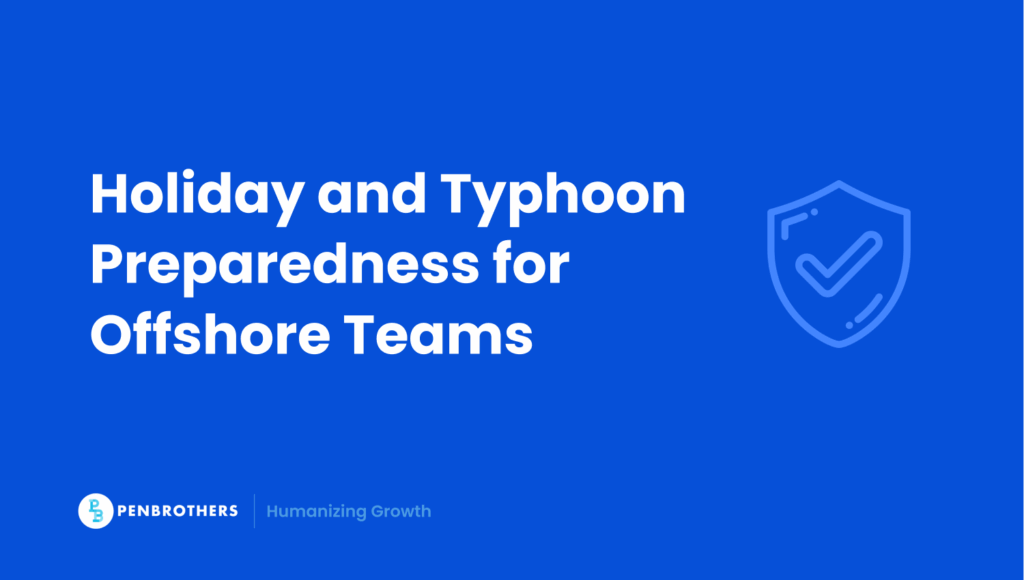Key Takeaways
- Business continuity in offshore staffing is about keeping delivery on track, not just having IT backups.
- The biggest risks are often in the details—unplanned holidays, sudden absences, and infrastructure hiccups can derail projects without proper planning.
- Before signing with a provider, demand clarity on their BCP, redundancy measures, drill frequency, and communication protocols.
- Top-tier partners prepare, test, and adapt through cross-training, multi-site coverage, and real-time performance monitoring.
- Penbrothers bakes resilience into operations, with a dedicated BCP team, proactive scenario playbooks, and a track record of zero SLA breaches.
It’s a Monday morning. Your offshore support team in the Philippines was supposed to handle 200 customer tickets, process month-end reports, and QA a product release. But a typhoon just knocked out power across Metro Manila. Your Slack is quiet. Your email? Filling up with complaints.
Your team isn’t lazy. They’re just… offline.
This is the kind of business continuity blind spot that many founders don’t see coming, until it costs them a key client, an SLA breach, or days of lost productivity.
In offshore staffing, continuity isn’t just an IT issue. It’s a delivery issue. And smart founders know to ask the right questions before signing a contract.
Business Continuity ≠ Just IT Backup, It’s a Delivery Guarantee
When most people hear “business continuity,” they think: data recovery, server redundancy, cyberattacks.
But if you’re outsourcing work to an offshore team, the real question isn’t “Will the servers survive?”, it’s “Will the work get done?”
Business continuity is about operational resilience. Can your team deliver even when:
- A Category 4 typhoon hits Luzon?
- A major holiday shuts down local operations for four days?
- A critical team member calls in sick or resigns?
This isn’t hypothetical. It’s an everyday risk, and your ability to deliver on client commitments depends on how well your offshore partner prepares for it.
What Offshore Partners Often Overlook
It’s easy to hear “uninterrupted service” in a sales pitch and assume the plan is bulletproof. But in reality, continuity depends on how well the finer points are handled day-to-day. Here are a few areas where the strongest offshore partners stand out:
Planning for Seasonal Disruptions
The Philippines is a vibrant, fast-growing market, and like any location, it has its own climate patterns. Leading providers anticipate seasonal weather events and have safeguards in place, from multi-site team distribution to rapid activation of work-from-home readiness.
Staying Connected Through Infrastructure Hiccups
Even in mature markets, internet or power interruptions can happen. The difference lies in preparation, like equipping staff with mobile data options, UPS devices, and alternate work locations to keep workflows moving.
Keeping Delivery Smooth During Team Changes
People take leave, shift roles, or move o,n and that’s normal. What matters is having cross-training, backup coverage, and bench strength so no project is dependent on a single person’s availability.
Aligning Schedules Across Time Zones and Calendars
Philippine holiday schedules sometimes shift due to government announcements. A proactive partner syncs calendars in advance, offers flexible PTO, and adjusts timelines so delivery stays consistent year-round.
Example: See how we handle bank holiday management to prevent scheduling surprises and keep projects on track.
The Smart Buyer’s Checklist: Questions to Ask Before You Sign
Before you choose an offshore staffing partner, ask these 8 questions. If they can’t answer clearly, walk away.
- Do you have a documented Business Continuity Plan (BCP)?
Ask to see the actual plan, not just hear promises. It should include disruption scenarios and recovery protocols. - What’s your geographic redundancy strategy?
Can teams shift work to other regions (e.g., from Manila to Clark) during local outages? - Do you conduct regular BCP drills?
Tabletop exercises ensure teams don’t just plan, but practice response. - What’s your backup plan for power and internet failures?
Look for use of mobile hotspots, UPS devices, and alternate work locations. - How do you handle sudden absences?
Cross-training, shared roles, and bench support should be standard. - How do you manage holidays across time zones?
Floating holidays and synced calendars should be built into your planning, like our PTO framework. - How are you notified during a disruption?
Clear communication protocols, not just reactive updates, are critical. - What tools do you use for real-time attendance and performance tracking?
Transparency matters. Partners should offer visibility into staffing and shift changes.
Inside the Plan: What a Robust Offshore BCP Actually Looks Like
So what does real business continuity look like in offshore staffing? Here’s what top-tier partners, like Penbrothers, build into their operations:
Multi-Layered Disaster Readiness
- Weather-Triggered Activation: When storms or natural disasters are forecasted, the BCP is activated early. This includes remote readiness checks, advisory timelines, and team availability audits.
- Office + Home Redundancy: Team members are equipped with essential gear, power banks, UPS devices, mobile internet and have fallback access to offices or co-working spaces if travel is safe.
Role-Based Cross-Training and Backup Coverage
- Rotating Shifts & Shared Roles: No single point of failure. Coverage is shared across pods to handle unplanned absences or turnover.
- On-Call Support Options: Flex team members can step in during peak periods, sick leaves, or long holidays.
- Temporary Staffing: If capacity drops, short-term hires are facilitated quickly through internal resourcing pipelines.
Holiday and Absence Forecasting
- Advance Holiday Calendars: Clients receive full-year holiday forecasts, including sudden “holiday economics” changes by the Philippine government.
- Floating PTO and Time-Off Planning: Employees can swap holidays or take staggered PTOs that align with your project timelines.
- Early Time-Off Requests: Absences are mapped in advance and coverage plans built to avoid surprises.
Redundant Power and Internet
- WFH Readiness: All remote hires are equipped for home-based continuity, with a checklist of IT tools and internet fallbacks.
- Mobile Data & ISP Flexibility: Staff use LTE modems or multi-ISP connections in areas prone to outages.
- Office Access as Fallback: For key roles, office presence is an option during critical windows, subject to safety conditions.
Real-Time Attendance Monitoring
- Digital Tracking Systems: Penbrothers uses remote team management tools that offer real-time attendance dashboards, automated absence alerts, and compliance reporting, giving you visibility and control.
Drills and Tabletop Exercises
- Quarterly Simulation Scenarios: These test readiness across departments, from response timelines to client communications.
- Post-Event Reviews: After minor disruptions (like typhoons or tool outages), lessons learned are documented and protocols updated.
Penbrothers’ Embedded Business Continuity Framework
At Penbrothers, business continuity isn’t a feature, it’s a dedicated function with a full-time team responsible for planning, monitoring, and activating protocols whenever needed. This isn’t a reactive fix; it’s a proactive system designed to turn risk into reliability for our clients.
Dedicated Business Continuity Team
Our in-house BCP Team is on point 24/7, ready to respond to any operational threat, from typhoons to sudden staff absences. They work closely with HR, IT, and Operations to ensure continuity measures are always up to date and tested.
Disruption Scenarios and Response Playbooks
From typhoons to unexpected resignations, we’ve pre-built contingency plans with defined steps, fallback teams, and trigger thresholds. Each scenario includes:
- Escalation criteria
- Timeline benchmarks
- Communication SOPs
- Resource reallocation steps
Annual Tabletop Exercises
Our teams rehearse real disruption scenarios annually. This helps us:
- Identify process gaps
- Improve internal communication speed
- Align teams across HR, IT, and Operations
- Keep client impact to a minimum
Communication Protocols That Put Clients First
During a disruption, here’s what happens:
- BCP Team Rapid Assessment: The internal response team evaluates the situation and impact.
- People Accounting: We check in with affected team members to confirm safety, internet access, and availability.
- Client Notifications: The Customer Success team shares an official advisory detailing the event, who’s affected, what coverage looks like, and when full operations resume.
This proactive model ensures you’re never left wondering, you’re always informed.
Hybrid Infrastructure Setup
- Office Power and ISP Redundancy: Office hubs are equipped with generators and multiple ISPs.
- Remote Support: For home-based talent, we assist in provisioning mobile internet or power backups when needed.
Holiday and Storm Planning, Built In
We don’t just react to holidays or weather, we plan around them:
- Early notifications and shift mapping for peak typhoon months
- Holiday syncing with global calendars (e.g., US, AU)
- Optional floating holidays and flexible PTO planning
- Buffers around deliverables during potential slowdown periods
Track Record
In the past year, Penbrothers experienced minor disruptions (typhoons, tool outages), but no major incident stopped operations. Thanks to our BCP protocols, we ensured:
- Timely work-from-home activation
- Backup resource allocation
- Zero SLA breaches across our client base
Want proof? See how we support time-off scheduling in advance through our PTO planning approach, or how we help clients align bank holiday management with their business cycles.
Final Thoughts
Founders don’t plan for worst-case scenarios because they expect them; they plan because they can’t afford not to.
Offshore staffing shouldn’t create new risk. With the right partner, it actually reduces it.
At Penbrothers, our clients don’t just hire talent, they hire a resilient delivery system that’s built to absorb shocks, communicate fast, and keep operations moving.
So before you sign that contract, ask:
“Does this partner have my back when things go wrong?”
Because in global business, resilience isn’t a luxury. It’s a requirement.






